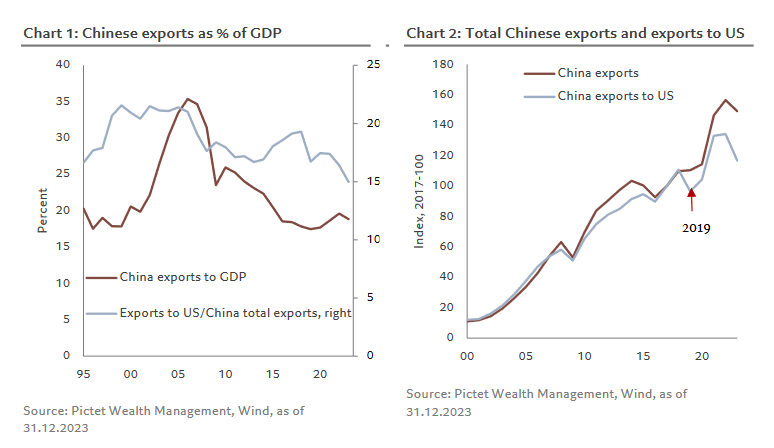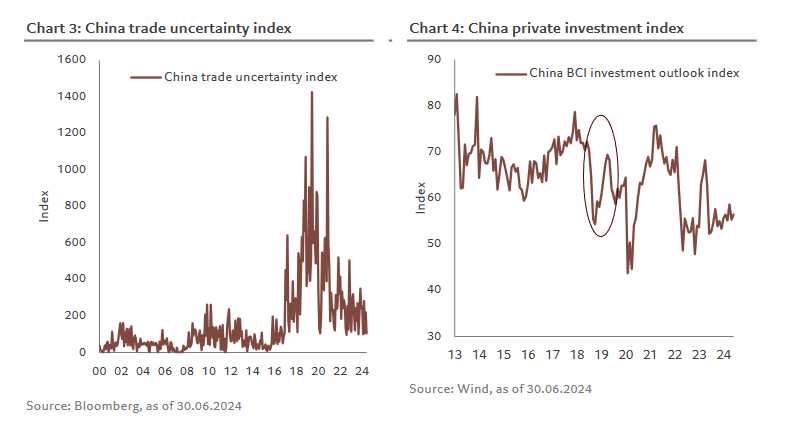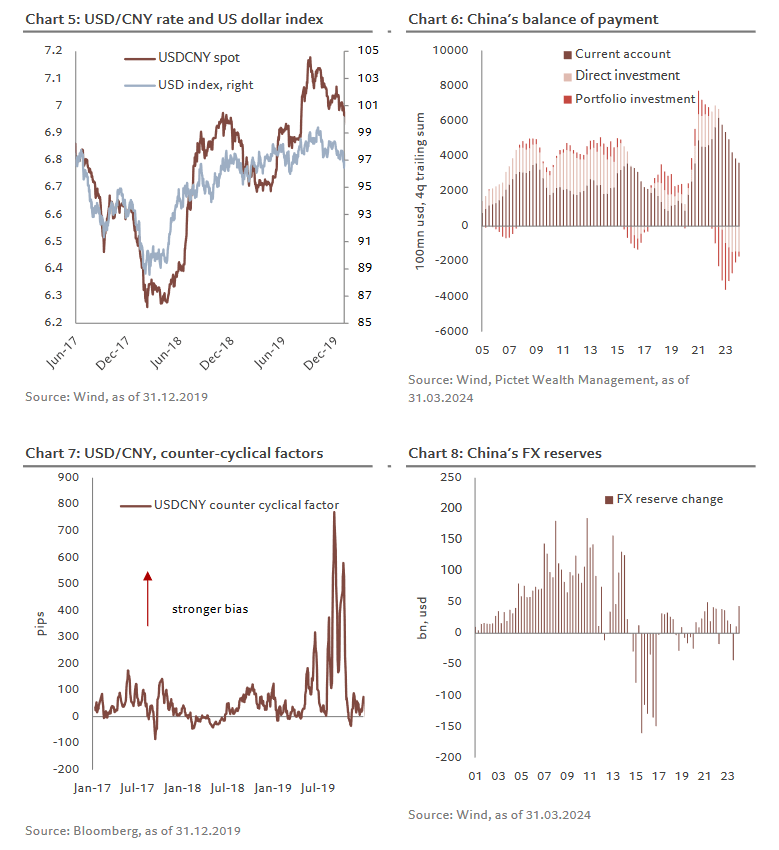Zhennan Li, Senior Asia Economist, Pictet Wealth Management.
The economic impact on China could be significant.
- The US and Europe have recently announced big tariffs on targeted Chinese products such as electric vehicles, but the impact on Chinese GDP should be limited. However, a move by the US to impose a flat 60% tariff on Chinese imports, as proposed by former US president and presidential candidate Donald Trump, could reduce China’s growth significantly. The direct impact of such tariffs could be to knock over 1% off Chinese GDP. They could also hurt Chinese firms’ investment plans and lead to a significant depreciation of the renminbi.
- China could respond by significantly ramping up policy support. It could also impose retaliatory tariffs on imports from US, limit some key exports to that country or sell US assets.
SIGNIFICANT NEGATIVE IMPACT ON CHINA’S GROWTH
Direct impacts on exports. US exports account for around 15% of total Chinese exports (down from around 19% in 2018, chart 1). Goods exports account for around 19% of Chinese GDP (around 70% of the value of China exports contains domestic value added). Assuming tariffs were fully transmitted to end prices and assuming the price elasticity of China’s exports is -1, the direct impact on China’s GDP of a 60% tariff on all China exports to the US could be roughly calculated as 15%19%70%160%= 1.2pp. There was a notable decline in Chinese exports to the US in 2018-2019 when the US imposed tariffs ranging from 7.5%-25% on around USD350 bn of Chinese goods. But the overall slowdown in exports was less pronounced, with export rerouting (chart 2) mitigating the impact on growth.

Indirect impact through higher uncertainty and lower private investment. Trade tariffs could lead to a rise in uncertainty and thus weigh on firms’ capex decisions. The uncertainty sparked by the 2018-2019 US tariffs (chart 3) led to a significant downturn in Chinese firms’ investment intentions during that period (chart 4). Of course, it is difficult to know the impact of fresh 60% tariffs on capex, but it is unlikely to be negligible.

SIGNIFICANT DOWNWARD PRESSURE ON RMB
A sharp increase in tariffs would put significant depreciation pressure on the renminbi (RMB). The currency weakened significantly against the US dollar (with USD/CNY rate moving from around 6.3 to 7.2) when President Trump unleashed tariffs in 2018-2019, driven by stronger broad dollar (chart 5) and a worsening balance of payments (chart 6). Meanwhile, the People’s Bank of China (PBOC) pushed to create a more flexible FX regime, allowing market forces greater say in determining the RMB FX rate. Direct intervention through FX reserves has fallen sharply over the past several years (chart 8) while the PBOC has been increasingly using the counter-cyclical factor (chart 7) and other macro prudential tools to guide expectations and mitigate herding factors in the FX market.
The RMB could depreciate significantly if the US does impose a tariff of 60% on Chinese imports, although we believe the PBOC could again move to mitigate pressure through a variety of tools (it could also use its significant forex reserves to prop up the currency and state banks could step up their RMB purchases, for example).

HOW MIGHT CHINA RESPOND TO 60% US TARIFFS?
- Domestic policy. The authorities could unveil more stimulus to support growth. Maintaining a decent level of economic growth is very important for the Chinese government. Policy support was ramped up significantly in response to the shock produced by the Trump tariffs of 2018-2019 (as well as to deal with domestic difficulties). We believe the authorities would act similarly if there were another sharp rise in US tariffs and move to support growth through a combination of fiscal, monetary and credit policy.
- External policy. The Chinese authorities have several retaliatory options. They could simply impose tit-for-tat tariffs on imports from the US as they did in 2018-2019 (although the value of Chinese exports to the US (USD500 bn) is much higher than the value of US exports to China (USD150 bn)). Alternatively, they could limit some key exports needed by US industry (it is worth remembering that China accounts for around 70% of the global production of rare earths), or they could decide to sell down US assets (for example, China’s considerable holdings of US Treasuries).




